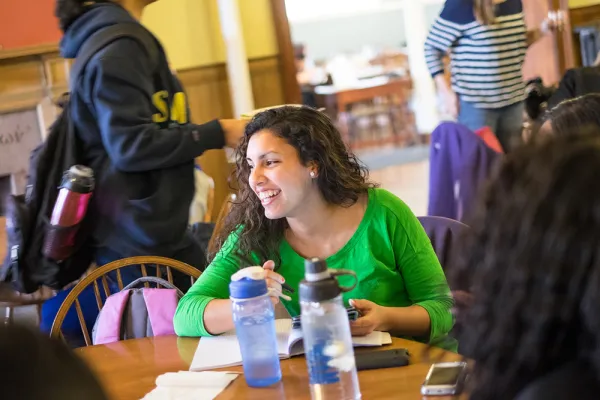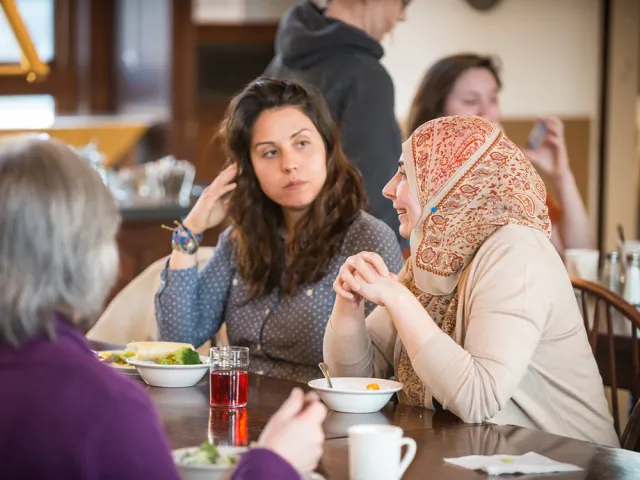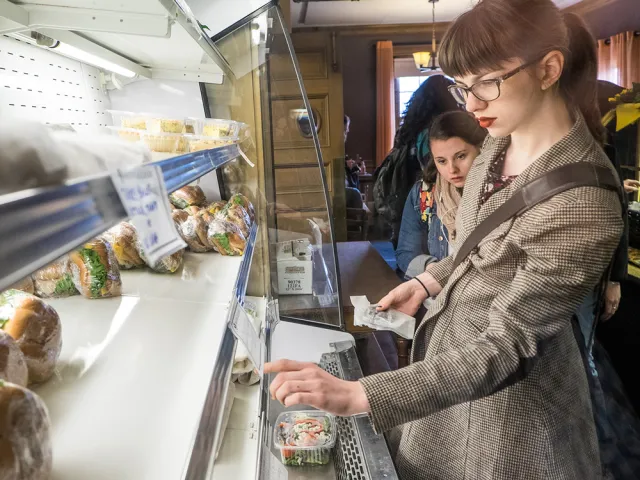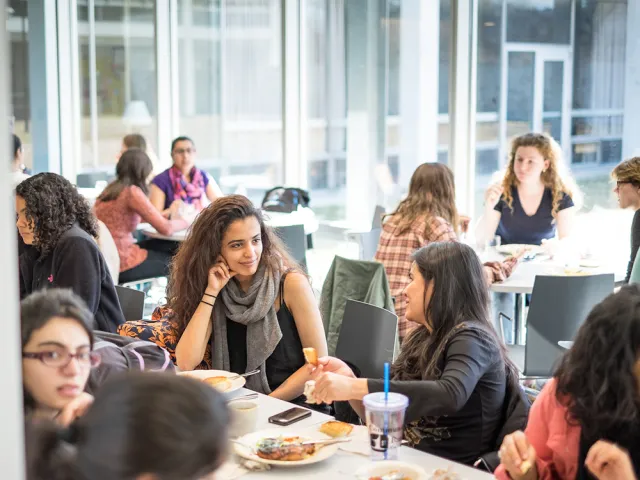Shaping a Contemporary Definition of ‘Home’
Campus Life

Published November 22, 2019
What does it mean to live and dine in community?
That’s the question being addressed by the Residential Experience Working Group—18 students, faculty and staff whose official charge is to examine “how Smith can most effectively optimize the potential of living and dining in community, in order to create an inclusive learning environment for all students.”
In other words, says REWG chair and Dean of the College Susan Etheredge ’77, “We're trying to come up with a contemporary definition of home.”
In March 2019, the REWG delivered its first set of recommendations, around residential life at the college.
Now the group is focusing on what it means to dine in community at Smith.
In May, after several months of surveys, research and student focus groups, the REWG submitted a preliminary report to President Kathleen McCartney and the Board of Trustees, outlining recommendations about how to improve community within Smith’s dining system.
In October, the trustees approved a technical feasibility study—an assessment of dining facilities, locations, hours and student need—designed to identify potential improvements.
Here’s what several of the committee members said about the group’s ongoing work.
Why is the Residential Experience Working Group examining dining at Smith?
Ryenne Carpenter ’19, former chair of the House Presidents’ Association: “Dining isn’t just about walking into a dining hall and sitting down with a plate. Food is a form of fellowship—it says something about a person’s culture, their identity, their experience. And it’s a way for students to connect—with each other, and with faculty and staff.”
Susan Etheredge ’77, dean of the college and vice president for campus life: “There are many reasons we need to look at this now. The big reason is what students expect when they come to college today. I remember with great nostalgia dining in my house for three meals a day and loving it. It worked then, but it doesn’t work now, for a whole host of reasons. Our group’s work is about moving in a direction that will better meet the needs of today’s students and tomorrow’s students. And it’s all about building an inclusive community.”
Andy Cox, director of dining services: “One hundred percent of what we do [in Dining Services] is about meeting student needs. Those needs are changing—in terms of what students want to eat, when they want to eat, where they want to eat. This study will allow us to work in a way that works better for our students.”

What does existing research tell us about students’ dining needs?
Jenna Pepe ’19, former Student Government Association president and Senate chair: “It’s difficult to create opportunities to live and dine in community at Smith because students today are so busy: They have to grab lunch before their next class; they have to rush to get to dinner after team practice; they want to be able to get hot food before a late night out on a Friday. So some of the things that students like are the new grab-and-go-meals, and the later hours in Tyler and Emerson. Students appreciate that vegan and vegetarian options are now available in a range of dining halls, instead of just one.”
Ryenne Carpenter: “There’s also a convenience of location; there are always two or more dining halls within five minutes of where you are.”
What are the challenges?
Andy Cox: “We provide a lot of options: Students might have, for example, 15 different dining halls that they can go to throughout the week—but our chefs don't necessarily know who's coming or when, so we have a significant overproduction problem for food. At the same time, students and staff are really interested in their own carbon footprint and what Smith is doing around sustainability. So our desire for convenient locations is at odds with our desire to be sustainable.
“Also, Smith’s ability to accommodate individual diets—vegan, halal, kosher, gluten-free, and so on—exceeds what our peers are doing. But students who are in a friend group with one gluten-free person, a vegan and a halal student have to go to three different places to get their meal. Sometimes they'll all pack it up and meet up for a meal together; but I think allowing students to engage more naturally around having multiple options at a given location would allow us to do better at building community, and also allow all students to have a better dining experience.”
How will this year’s feasibility study work?
Susan Etheredge: “We’ve hired a consultant to help us assess Smith’s physical dining locations, equipment (refrigerators, ovens, and so on), and operations. That consultant will present the REWG with a report and range of recommendations in May 2020. After that, the REWG will host a series of conversations with the community to evaluate options and adapt the recommendations to Smith’s particular needs.”
Jenna Pepe: “Our goal is to look at how students eat at Smith. So the study needs to consider what students eat, where they get it, and when food is available.”

What does the research tell us about what could be improved?
Andy Cox: “Our students today come from all over the world, and their expectations of what dinner should look like are drastically different from what they were 20 or 30 years ago. We're not heavily dependent on an animal protein in the middle of the plate, with starch and a veg. Students want international flavors; they want authentic cuisines. They want local ingredients, and they want to be able to customize those ingredients to their palates.”
Susan Etheredge: “What we have now is a community in motion. Students text each other—‘Who’s doing vegan tonight?‘ ‘Which dining room has the best dessert?’—and then meet up in the place that they think has the best menu.”
Jenna Pepe: “Students would like to have even longer hours, higher food quality, and a broader range of menu options. They’d also like to have informal food options—small places in the houses where students could gather to cook.”
Ryenne Carpenter: “Students would like to have dietary options in all locations, not just some. And there’s a real need to do more thinking about physical space and accessibility; some of the dining halls aren’t physically accessible right now. It would also be ideal to have space in each dining hall for those who cherish group conversations, and also those who prefer to dine on their own.”
Susan Etheredge: “I’d also like to see better support for faculty and staff who want to engage with students over food. We need something that’s efficient, but also convivial.

So does this mean Smith will have consolidated dining?
Susan Etheredge: “It’s really too soon to say what the outcome will be! We’re not going into this with any predetermined ideas. My hope is that we’ll look at a range of options—from no change at all, to something that looks different from what we have now.”
Jenna Pepe: “While there are general themes that students want to see improve, our research didn’t show a mass push for one model of dining. We found there were common qualities students wanted to change about dining, but no overall consensus about what exactly the solution looks like.
“Students today feel that dining is special—and also that there’s room for improvement. You could say Smith is unique because we allow dessert-hopping—getting dinner in one hall, dessert in another—but is that really what we want to be known for? We want to figure out how to keep Smith’s historical distinctiveness within a changing system.”
What do you hope the REWG’s work will accomplish? What will students be saying about Smith dining five years from now?
Jenna Pepe: “I’d like to people to be excited about food and dining at Smith! I want people to feel excited and invited.”
Susan Etheredge: “I’m sure that whatever we come up with will be uniquely Smith. I mean, yes, we still have tea, and we’ll always have tea. But even tea has changed—sometimes it’s on Sunday afternoons, and sometimes it’s bring your own water bottle and there’s no tea at all (at the students’ request). We’re respecting Smith’s special and unique traditions as we engage in this work.”